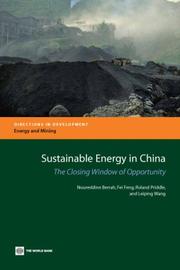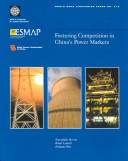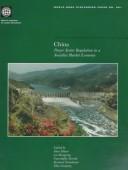| Listing 1 - 6 of 6 |
Sort by
|

ISBN: 0821367536 9786610765775 1280765771 0821367544 9780821367537 Year: 2007 Publisher: Washington, DC : World Bank,
Abstract | Keywords | Export | Availability | Bookmark
 Loading...
Loading...Choose an application
- Reference Manager
- EndNote
- RefWorks (Direct export to RefWorks)
This timely new book uses historical data from 1980 and alternative scenarios through 2020 to assess China's future energy requirements and the resources available to meet them. Current trends are putting China on an unsustainable and insecure energy growth path, characterized by the use of enormous quantities of ""dirty"" coal and an alarming oil import dependence. The authors find that what is urgently needed is a high-level commitment to an integrated, coordinated, and comprehensive policy that is set in the framework of the energy law currently being prepared.
Energy industries. --- Energy industries --- Energy policy --- Energy development --- Business & Economics --- Industries --- Environmental aspects --- S10/0523 --- S20/0500 --- -Energy policy --- -Energy development --- -333.790951 --- Energy resources development --- Energy source development --- Power resources development --- Power resources --- Energy and state --- State and energy --- Industrial policy --- Energy conservation --- China: Economics, industry and commerce--Power supply (electricity, mining, oil) and computing industry --- China: Agriculture forestry, fishery, natural disasters--Environmental policy, pollution --- -Environmental aspects --- -Government policy --- -Energy industries. --- Government policy --- 333.790951
Book
Year: 2013 Publisher: Washington, D.C., The World Bank,
Abstract | Keywords | Export | Availability | Bookmark
 Loading...
Loading...Choose an application
- Reference Manager
- EndNote
- RefWorks (Direct export to RefWorks)
With rapid development of wind power in China, the following three issues have become barriers for further scale-up: 1) concentration of wind farms in the Three-North region, which became significantly underutilized because of a limited capability of local power grids to off-take and consume wind-generated electricity and because of a lack of coordinated development of long-distance transmission lines to deliver electricity to load centers in the South and East regions; 2) increasing subsidies and, thus, a burden on final consumers; and 3) resistance of local authorities to develop new projects because the new value added tax policy reform. How to deal with these issues will have significant impact on the future development of wind in China. This note proposes a methodology to enhance a comprehensive approach by taking both generation and transmission into account in crafting the development plan and formulating the incentive policies, which may be useful in addressing these issues.

ISBN: 0821347438 Year: 2001 Publisher: Washington, D.C.
Abstract | Keywords | Export | Availability | Bookmark
 Loading...
Loading...Choose an application
- Reference Manager
- EndNote
- RefWorks (Direct export to RefWorks)
Relation between energy and economics --- China --- S10/0523 --- China: Economics, industry and commerce--Power supply (electricity, mining, oil) and computing industry --- Competition --- Electric utilities --- Electric companies --- Electric light and power industry --- Electric power industry --- Electric industries --- Energy industries --- Public utilities

ISBN: 0821339133 Year: 1997 Publisher: Washington, D.C.
Abstract | Keywords | Export | Availability | Bookmark
 Loading...
Loading...Choose an application
- Reference Manager
- EndNote
- RefWorks (Direct export to RefWorks)
Electric power systems --- Electric utilities --- S10/0523 --- Electric companies --- Electric light and power industry --- Electric power industry --- Electric industries --- Energy industries --- Public utilities --- Power systems, Electric --- Systems, Electric power --- Electric power production --- Government policy --- Finance --- Management --- China: Economics, industry and commerce--Power supply (electricity, mining, oil) and computing industry --- World Bank. --- Public economics --- China --- Világbank --- Banque internationale pour la reconstruction et le développement --- Mezhdunarodnyĭ bank dli︠a︡ rekonstrukt︠s︡ii i razvitii︠a︡ --- MBRR --- Sekai Ginkō --- Kokusai Fukkō Kaihatsu Ginkō --- Kukche Puhŭng Kaebal Ŭnhaeng --- Segye Ŭnhaeng --- IBRD --- Welt Bank --- Weltbank --- Banque mondiale --- Internationale Bank für Wiederaufbau und Entwicklung --- Banco Internacional de Reconstrucción y Fomento --- Banco Mundial --- B.I.R.D. --- BIRD --- Banca Internațională pentru Reconstrucție și Dezvoltare --- Mirovoĭ Bank --- Svitovyĭ Bank --- Svitovyĭ bank rekonstrukt︠s︡iï i rozvytku --- Verdensbanken --- Międzynarodowy Bank Rozwoju i Odbudowy --- Bank al-Dawlī lil-Inshāʼ wa-al-Taʻmīr --- Bank al-Dawlī --- Världsbanken --- Banca ricostruzione e sviluppo --- Banca di ricostruzione e sviluppo --- BIRF --- I.B.R.D. --- B.I.R.F. --- Shih chieh yin hang --- Shi jie yin hang --- International Bank for Reconstruction and Development --- World Bank Group. World Bank --- Thanākhān Lōk --- Bank Światowy --- Viśva Baiṅka --- Lōka Băṅkuva --- Ngân hàng Thế giới --- Vsemirnyĭ Bank --- Bank Dunia --- Msopʻlio Bankis --- Banca Mondială --- BM --- Prapañca Byāṅku --- Banca mondiale --- Banca internazionale per la ricostruzione e lo sviluppo --- Dhanāgār Bibhab Lok --- البنك الدولي --- بنك الدولي --- 世界銀行 --- 世界银行 --- 国際復興開発銀行 --- Dėlkhiĭn Bank --- Дэлхийн Банк --- Hamashkharhayin Banki --- Svetska Banka --- Wereldbank --- Internationale bank voor herstel en ontwikkeling
Book
Year: 2001 Publisher: Washington, DC: World Bank
Abstract | Keywords | Export | Availability | Bookmark
 Loading...
Loading...Choose an application
- Reference Manager
- EndNote
- RefWorks (Direct export to RefWorks)
Book
Year: 2021 Publisher: Washington, D.C. : The World Bank,
Abstract | Keywords | Export | Availability | Bookmark
 Loading...
Loading...Choose an application
- Reference Manager
- EndNote
- RefWorks (Direct export to RefWorks)
China made impressive progress in developing renewable energy to provide access to clean energy and electricity to its predominantly rural population before the economic boom that followed the open door policy, by improving energy supply to the economy as the country industrialized and urbanized at an extremely fast pace and finally by fighting debilitating local pollution and mitigating the impact of climate change. Through that journey, China has accumulated a considerable amount of experience and learned many lessons. Its evolution from a low-income to a middle-high income country and its wide geographical diversity brought about extensive challenges, many of which are similar to those facing a wide range of developing countries who are willing to further rely on renewable energy to address their energy needs. This report attempts to present the Chinese rich and diversified experience and draw the lessons learned that may inform decision-making in these countries.
Energy --- Energy Efficiency --- Energy Policies and Economics --- Hydro Power --- Hydropower --- International Cooperation --- Renewable Energy --- Solar Energy --- Sustainability --- Windpower
| Listing 1 - 6 of 6 |
Sort by
|

 Search
Search Feedback
Feedback About UniCat
About UniCat  Help
Help News
News